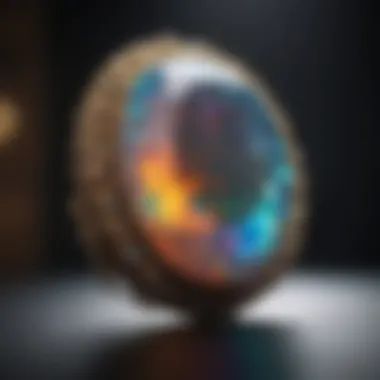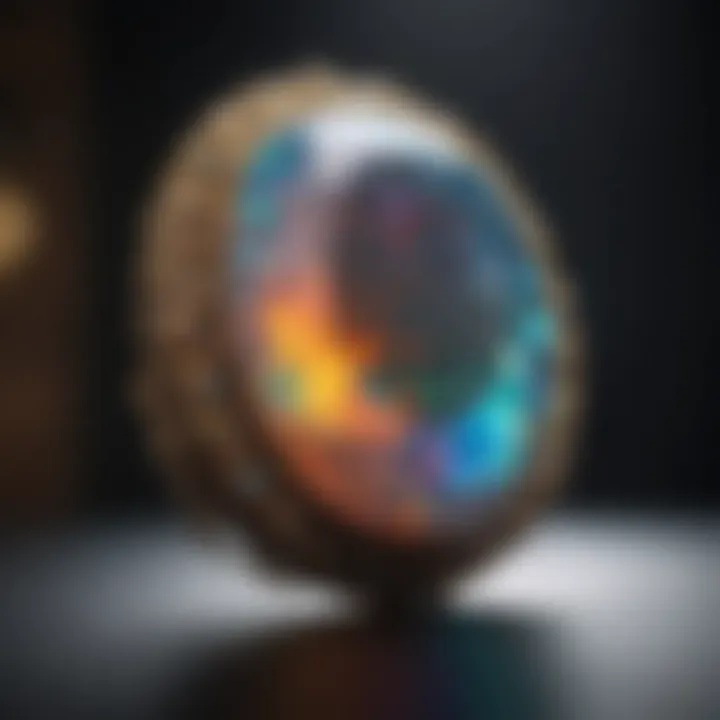Understanding Opal Valuers: A Comprehensive Guide


Intro
In the captivating world of gemstones, opals command a unique position. Their ever-changing play of color, often described as a dance of light, makes them particularly alluring. However, behind their beauty lies a complex ecosystem of valuation, which often goes unnoticed by casual admirers. Opal valuers are the gatekeepers of this knowledge, armed with expertise that stretches beyond mere appreciation of aesthetics. They delve into a variety of elements that affect an opal’s worth, transforming a raw stone into a prized possession.
Understanding opal valuers isn't just about grasping their roles; it's about recognizing the intricate dance between science and art that defines the gemstone industry. As we explore this topic, you'll gain insight into what makes an opal valuable, the skills required to ascertain its worth, and the ethical considerations that govern the evaluation process.
So, whether you're a seasoned collector or simply someone drawn to the mystique surrounding opals, this guide provides valuable perspectives that illuminate the path of opal valuation.
Gemstone Overview
Definition and characteristics
Opals are not just any gemstones; they're unique in their composition and appearance. They are a mineraloid, which sets them apart from most other gemstones that are crystalline in nature. This classification means they lack a specific atomic structure, resulting in their captivating play of color, known as 'opalescence.'
- Color variations: Opals can be found in a spectrum of colors—from whites, blues, and greens to fiery reds and blacks.
- Transparency: Some opals are nearly transparent, while others can be completely opaque, adding to their versatility for various types of jewelry.
- Water content: One of the fascinating features of opals is their water content, which typically ranges from 5% to 20%. This characteristic can influence their durability and visual effects.
Classification of gemstones
Understanding gemstones begins with their classification into various categories, which include:
- Precious gemstones: This includes diamonds, sapphires, and of course, opals. Their rarity and often higher market values place them in this category.
- Semi-precious gemstones: Stones like amethyst and aquamarine fall into this group. They may be less rare than precious gemstones but still hold significant value.
- Organic gemstones: Pearls and coral are examples of organic gemstones formed from biological processes rather than mineral formation.
Each class of gemstone possesses distinct characteristics, yet opals stand out due to their unpredictability, making each piece a unique find.
Properties of Gemstones
Physical properties
When it comes to valuing opals, physical properties are at the forefront of evaluations. Several key aspects to consider include:
- Hardness: Opals typically score a 5.5 to 6.5 on the Mohs scale, which means they are somewhat durable but also require careful handling.
- Density: The density of opals can influence their weight and, consequently, their value. Generally, a higher density can imply better quality.
- Luster: The way light interacts with the surface of the opal plays an important role in its allure. It can range from dull to vitreous, impacting aesthetic perception.
Chemical properties
The chemical makeup of opals diverges radically from those of crystalline gems, lending them unique attributes. For instance:
- Silica gel structure: Opals predominantly consist of silicon dioxide, but their gel-like structure allows for the trapping of tiny water droplets, contributing to their color play.
- Trace elements: The presence of trace elements like iron or cobalt can affect an opal’s color and overall appearance.
Altogether, these properties must be carefully examined and understood by opal valuers to deliver accurate appraisals, ensuring the gem's rarity and beauty are duly recognized.
"An opal that captivates isn't just luck; it's knowledge, expertise, and a touch of art."
As we move forward in this guide, we'll unravel the specific methods employed by valuers and the ethical dimensions surrounding the trade of these remarkable gemstones.
Defining Opal Valuers
Understanding what an opal valuer does is crucial for anyone involved in the gemstone world. These experts play an integral role in determining the worth and quality of opals. With so many factors influencing an opal's value, having a knowledgeable opal valuer can make all the difference in a purchase or sale.
The Role of an Opal Valuer
An opal valuer is not merely someone who gives a price tag to a piece of stone; they are skilled professionals equipped with a deep understanding of the opal market and the intricacies of these gemstones. The valuer integrates technical skills and keen observation to assess various attributes of opals, such as color, clarity, size, and play of color.
These experts utilize specialized tools and techniques for their assessments. For instance, a dichroscope can help in examining the play of color more thoroughly, while a loupe may be employed for inspecting clarity. Their comprehensive analysis results in a detailed report, which can inform both buyers and sellers on expected values.
In essence, an opal valuer serves as a bridge between the technical aspects of gemstones and the monetary values assigned in the marketplace. Without their expertise, buyers may end up overpaying, while sellers might face undervaluation of their prized opals.
Importance in Gemstone Trade
Opals can be a significant financial investment, but their value can swing like a pendulum. Here, opal valuers play a compelling role in stabilizing this fluctuation. By accurately assessing the value of these stones, they help maintain a fair marketplace. Their insights contribute to informed decisions by buyers and sellers alike.
- Legitimacy of the Gemstone Trade: Opal valuers help ensure that the trade is conducted in good faith. Their assessments prevent scams or misunderstandings, especially when it comes to expensive specimens.
- Market Insights: They often have an in-depth understanding of market trends, allowing them to provide valuable advice on when to hold or sell an opal.
- Quality Assurance: An opal valuer's approval often acts as a stamp of quality, enhancing a gemstone's desirability. Consumers tend to trust stones that have been valued by a recognized expert.
"A knowledgeable opal valuer not only enhances the buying experience; they ensure the industry retains its integrity."
Criteria for Opal Valuation
In the vibrant realm of gemstones, valuing opals is a particular art; it calls for a discerning eye and a robust understanding of numerous factors. The criteria for opal valuation encompass several key elements, each contributing uniquely to the overall worth of this stunning gemstone. For those in the industry, or even just passionate enthusiasts, grasping these criteria is essential. It not only aids in making informed purchasing decisions but also enriches the appreciation of opal itself.


Color and Play of Color
The first and perhaps most significant factor in opal valuation is its color and, notably, the play of color. Opals are renowned for their captivating hues, ranging from fiery reds and oranges to serene blues and greens, and everything in between. But what truly sets one opal apart from another is the phenomenon known as the 'play of color,' which describes the shifting colors that can emerge as the stone is viewed from different angles.
- Desirability of Colors: Lighter opals, like white or crystal ones, often exhibit a broader spectrum of color, while black opals, credited for their dark backgrounds, provide a vivid contrast that emphasizes the brilliance of the colors.
- Rarity: Opals with rare colors, such as deep purple or bright pink, tend to command higher prices due to their scarcity in nature.
Given that many buyers seek opals for their striking visual appeal, this criterion is not merely technical but also deeply intertwined with personal taste and market demand.
Transparency and Clarity
Another vital criterion is transparency and clarity. While light opals might shimmer beautifully, the clarity of the stone can significantly impact its valuation. Opals can range from completely transparent to mildly opaque. Here’s what to keep in mind:
- Clarity Levels: Clean stones, devoid of visible inclusions or blemishes, are typically valued higher because they permit light to pass through freely, enhancing their play of color.
- Imperfect Stones: However, some inclusions can add unique character to a stone, similar to how a photograph with a grainy texture can evoke emotion or nostalgia.
Thus, determining the right balance between transparency and the character of the opal can be quite nuanced.
Cut and Shape
The cut and shape of an opal are equally important in valuation. Unlike diamonds which often boast standardized cuts, opals are typically fashioned in freeform designs or unique shapes to enhance their natural beauty.
- Artistic Cut: A well-cut opal can enhance its lustre and the depth of color, showcasing its best features. Plump cabochons are generally favored, as they allow for a substantial surface area to display the play of color.
- Demand for Cuts: Specific cuts may trend among collectors; for instance, a round or oval shape may be popular for jewelry items, making these cuts more desirable in the marketplace.
The effectiveness of the cut significantly affects an opal's overall appeal, thereby influencing its market price.
Size and Weight
Lastly, size and weight hold considerable clout in opal valuation. Generally, larger opals showcase more comprehensive color patterns and play of color, which boosts their attractiveness.
- Measuring Value: A common guideline is the notion that "the bigger, the better," but quality must not be sacrificed for size. A small, high-quality opal might outshine a larger, poorly exhibiting stone.
- Carat Weight: In gemstone trading, weight is commonly expressed in carats. As the weight increases, the value tends to increase quadratically rather than linearly due to the law of supply and demand in the market.
In essence, size and weight provide a quantifiable measure that can significantly influence the final appraisal of an opal.
Understanding these criteria is not simply for the sake of valuation; it enriches the overall experience of engaging with opals, allowing enthusiasts and professionals alike to appreciate these mesmerizing stones in a deeper and more nuanced way.
Types of Opals
Understanding the types of opals is fundamental to grasping the intricacies of opal valuation. While all opals share certain surface features, their underlying characteristics have a significant impact on their rarity and worth. Recognizing the differences not only aids in appreciation but also informs purchasing decisions for collectors and jewelers alike.
Natural vs. Synthetic Opals
Natural opals come from the earth, forming over thousands of years through a complex geological process. They embody nature's art, showcasing a spectrum of colors and patterns specific to their formation environment. The allure of natural opals lies in their authenticity and unique characteristics, which tell a story of time and place.
Conversely, synthetic opals are lab-created through controlled processes that mimic the natural formation conditions. Although they can exhibit the same striking visuals as their natural counterparts, they lack the historical narrative and geological significance. It’s crucial for buyers to discern between the two, as the value of natural opals can reach astronomical heights, while synthetic versions generally cost a fraction of the price. In other words, while some might say all that glitters is gold, in the opal world, that glitter might just be a clever imitation.
Key distinctions often considered include:
- Origin: Natural opals originate from the earth, while synthetic versions arise from human ingenuity.
- Value: Typically, natural opals are more valuable due to their rarity and the charm of their provenance.
- Characteristics: Natural opals can have inclusions and imperfections that make each piece unique, unlike the often flawless synthetic gems.
"In the gemstone market, origins dictate the story; a natural opal tells tales of centuries, while a synthetic one speaks of modern craftsmanship."
Origin and Rarity
The origin of opals plays a pivotal role in their valuation. Australia, known as the opal capital of the world, produces the most sought-after varieties, including Black, Boulder, and White opals. These gems, particularly from regions such as Coober Pedy and Lightning Ridge, command a premium due to their characteristics and the scarcity of high-quality finds.
Other notable sources include Ethiopia and Mexico, each contributing unique variations to the opal family. For instance, Ethiopian opals are known for their vibrant play of color and unique translucence, while Mexican opals often exhibit intense color play with a milky base.
Rarity is another key factor; the less common the opal type, the more valuable it becomes. For instance, precious opals that display a play of color are notably rarer than common opals, which don’t exhibit this phenomenon. As collectors or aficionados delve into the opal world, understanding the connection between origin and rarity can significantly enhance their appreciation and assessment of the gemstones they encounter.
Factors influencing rarity and value:
- Locality: Certain regions yield gems with more desirable characteristics.
- Demand: As tastes change, so does the demand for specific types or sources of opal.
- Natural occurrences: Events like mining limitations and natural disasters can drastically affect availability.
In sum, whether one is scouting for that special gem or simply expanding knowledge, the types of opals and their unique attributes create a complex tapestry worth exploring.
Methods of Opal Valuation
The world of opal valuation embraces both artistic and scientific dimensions. Opal valuers employ various methods to assess and determine the authenticity and worth of these gemstones. Understanding these methods is crucial, especially for those involved in the buying, selling, or collecting of opals. The techniques not only add credibility to the valuation process but also aid in establishing trust between valuers and clients. Works of art or nature, opals demand a meticulous approach to valuation that does justice to their beauty.
Visual Inspection Techniques


At the heart of opal valuation lies the practice of visual inspection, the first line of evaluation for any valuers. This technique is founded on the expert’s ability to discern the subtle qualities and characteristics present in each opal. During inspection, a valuer examines key aspects such as color, clarity, and overall integrity of the stone.
- Color Assessment: The play of color is what makes opal stand out. From vibrant reds and fiery oranges to calming blues and greens, each hue tells a story. An experienced valuer inspects these colors under different lighting conditions to reveal the true nature of the gem, including any overtones or underlying hues that may not be apparent at first glance.
- Surface Examination: Any imperfections on the surface can speak volumes about the opal’s history and durability. A closer look at symmetry and polish quality can identify if the stone has been crafted with skill or if it might have defects that could impact its market value.
- Lighting Techniques: Proper lighting is critical during inspection. For instance, using a light box can help in observing the play of color more clearly. It is like examining a painting under different lights – what might look dull in one light could burst with life in another.
This hands-on evaluation requires a keen eye and extensive experience. Although subjective, visual inspection offers immediate insights that guide valuers towards a preliminary valuation.
Use of Technology in Valuation
With advancements in technology, the gemstone industry has seen a shift in the way opals are evaluated. Various tools and machines now complement traditional inspection methods, enhancing accuracy and efficiency. Valuers must adapt and incorporate these technologies to maintain their edge in a competitive market.
- Gemological Instruments: Instruments like refractometers, spectroscopes, and microscopes help in analyzing fine details. Such tools facilitate the examination of internal characteristics and light behavior within the stone, adding a layer of scientific rigor to the valuation process.
- 3D Imaging: Some cutting-edge valuers employ 3D imaging technology to create detailed representations of the opal. This allows for a comprehensive view of the stone, highlighting features that are often hidden from the naked eye. It can also be invaluable for online sale platforms, offering potential buyers a closer look at the product before purchase.
- Certifications through Labs: Many valuers partner with gemological laboratories for advanced testing. These labs offer grading reports, verifying authenticity and quality based on standardized criteria. The auxiliary validation from a renowned lab can lend significant weight to an independent valuer’s assessment.
To truly gain a robust understanding of opals, consider their valuation a bridge between the dazzling visual spectacle and the technical analysis behind their worth.
Qualifications of Opal Valuers
When stepping into the fascinating realm of opal valuation, there's a critical aspect that can't be overlooked: the qualifications of the valuers themselves. The expertise and background of an opal valuer play a pivotal role in determining the authenticity and worth of these unique gemstones. With the market flooded with different types of opals—some genuine and some imitations—the valuation process becomes a matter of utmost precision. So, what sets qualified opal valuers apart? Let's dive into their educational background and professional certifications, two key pillars that ensure they are up to the task.
Educational Background
The journey to becoming a skilled opal valuer typically begins with a solid educational foundation in gemology. Many valuers possess degrees or diplomas from reputable institutions that specialize in gem and jewelry studies. This formal education equips them with essential knowledge about various gemstones, including opals, and cultivates an understanding of the geological processes involved in their formation.
Learning about the physical and optical properties of opal is crucial. For instance, a valuer should know that opals exhibit a unique phenomenon called play-of-color, where light interacts with the silica spheres within the stone, producing brilliant flashes of light. Without this educational background, a valuer may lack the insight required to assess an opal’s true value effectively.
Moreover, attending workshops or seminars focused on opals, particularly those covering advancements in technology and appraisal techniques, can significantly enhance a valuer's knowledge. As the saying goes, "You can’t teach an old dog new tricks," but ongoing education helps valuers stay sharp and proficient in their assessments.
Professional Certifications
Besides formal education, professional certifications serve as a badge of credibility for opal valuers. Institutions like the Gemological Institute of America (GIA) and the International Gemological Institute (IGI) offer certifications specifically designed to assess gemstone grading and valuation skills. Obtaining such certifications requires passing rigorous examinations and demonstrating hands-on experience in evaluating genuine opals.
Certifications not only showcase a valuer's skills but also instill confidence among clients. When collectors or jewelers seek an appraisal, they often look for certified valuers, knowing that the expertise is backed by an established authority in the field.
In addition to GIA and IGI, recognizing other local or regional certification programs can also be beneficial. These pathways can bridge a valuer's understanding of local market conditions and preferences, which might differ from global standards.
"The difference between a practiced eye and an amateur’s gaze lies within the depth of training and the array of experiences that a valuer undergoes."
Overall, the qualifications of opal valuers—spanning their educational background and professional certifications—cultivate a standard of excellence in the opal valuation process. Knowledge combined with accredited skills creates a reliable resource for anyone looking to navigate the world of opals, whether for purchase, sale, or collection purposes.
Challenges Faced by Opal Valuers
Valuing opals is not just about appreciating their beauty; it's also about navigating a landscape rife with challenges. The role of opal valuers is critical in establishing the worth of these gemstones, yet they face numerous hurdles that demand skill, experience, and a bit of finesse. Understanding these challenges sheds light on the complexities involved in the evaluation process and highlights the importance of having expert valuers in the market.
Market Fluctuations
One significant challenge in the realm of opal valuation is the ever-changing market dynamics. The prices of opals can swing like a pendulum, influenced by factors such as supply and demand, global economic trends, and consumer preferences. Opal valuers must stay on their toes, constantly analyzing market behavior. For instance, a sudden surge in demand for black opals due to a fashion trend can drastically raise their market prices overnight, while a dip in interest might leave valuers scrambling to adjust their assessments.
Factors that can lead to market fluctuations include:
- Seasonal Demand: Holidays and special occasions can create spikes in opal sales.
- Global Economic Conditions: An economic downturn may cause jewelry sales to plummet, impacting the overall value of opals.
- Artistic Trends: Changes in jewelry design preferences can elevate or diminish the desirability of certain opals.
Opal valuers need to be well-informed and flexible, adjusting their valuations accordingly. Without this adaptability, they risk providing outdated assessments that could mislead buyers, sellers, or collectors.
Counterfeit and Imitation Stones
Another elephant in the room for opal valuers is the presence of counterfeit and imitation stones. The gemstone market has always been a playground for scammers, and opals are no exception. Imitation stones, often made from resin or glass, can resemble genuine opals closely. This renders the experience and skills of valuers absolutely essential. A novice or inattentive valuer may mistake a synthetic or imitation stone for the real deal, leading to potential losses for clients and a tarnished reputation for themselves.
Some common types of counterfeits include:
- Doublets and Triplets: These are layers of opal fused with other materials, designed to enhance appearance while reducing costs.
- Resin-Encased Stones: Opals can be embedded in resin, creating a beautiful façade that masks underlying flaws.
- Synthetic Opals: While made from the same minerals, synthetic opals are created in a laboratory and lack the unique history and rarity of natural opals.
To effectively combat these challenges, opal valuers often employ a range of methods, including advanced testing technology and expert visual inspection techniques. Their ability to discern the genuine from the fake is paramount. Ensuring transparency and trustworthiness in the gemstone market not only bolsters customer confidence but also maintains the integrity of the valuation process.
Understanding these challenges is vital not just for valuers but for all stakeholders in the opal trade. By recognizing the potential pitfalls, buyers can make more informed decisions, while sellers can better appreciate the expertise required in valuation.
The Ethical Dimension of Opal Valuation
The world of opal valuation is not just about numbers and assessments based on visual traits of the stones; it extends far beyond that to encompass ethical considerations. In today's rapidly evolving gemstone market, understanding the ethical dimension of opal valuation is paramount. This approach emphasizes responsible sourcing, sustainability, and fair pricing, ultimately enhancing the integrity of the gemstone industry in a way that is both respectful and beneficial to all stakeholders involved.


Sourcing and Sustainability
When it comes to opal valuation, the means by which the stones are sourced is crucial. Ethical opal valuers prioritize gemstones that are not only beautiful but also procured from mines that observe sustainable practices. This means ensuring that the mining methods do not devastate local communities or ecosystems. As consumers grow increasingly conscious of the origins of their purchases, the role of valuers who can verify and certify responsible sourcing becomes even more significant.
- Community Involvement: Ethical miners often engage local communities, providing jobs and ensuring that their workers benefit from the resources extracted from the earth. This creates a positive feedback loop—workers earn fair wages and communities thrive, all while maintaining the ecological balance.
- Reducing Environmental Impact: Sustainable practices aim at minimal disruption to the land. New techniques and technologies, such as using less invasive extraction methods or rehabilitating mining sites, help reduce long-term ecological damage. These efforts not only preserve the environment but also add value to the opals by portraying them as ethically sourced.
- Certifications: To fortify their commitment to ethical practices, many opal valuers seek out certifications that demonstrate adherence to environmentally friendly mining and sourcing methods. Establishing such credentials is vital for transparency in the market, offering buyers additional assurance regarding the legitimacy of their purchases.
Transparency in Pricing
A significant aspect of the ethical dimension of opal valuation lies in transparency in pricing. Valuers must appraise and communicate the value of opals in a manner that is straightforward and fair. This is important not only for building trust with clients but also for setting realistic market expectations. In an arena rife with ambiguities and discrepancies, valuers play a key role in demystifying the pricing process.
- Clear Communication of Value Factors: Valuers need to break down the factors that contribute to an opal’s valuation—color, clarity, cut, and other criteria—in a way that is understandable to collectors and retailers. Providing a holistic pricing structure can prevent misunderstandings and potential disputes in the future.
- Avoiding Markup Pitfalls: Some valuers might inflate prices to line their pockets, either through less experienced clients or misrepresenting the quality of stones. Ethical valuers refrain from doing this and instead offer an honest appraisal, ensuring that the prices reflect true market value according to current demand and rarity.
- Openness to Scrutiny: Ethical valuation practices advocate for openness. This means being willing to discuss valuation methodologies, answer questions, and provide necessary documentation or certifications. Such transparency helps cultivate trust among buyers and sellers in the gem market, which ultimately elevates the entire industry.
"The gemstone industry relies not only on the brilliance of the stones but also on the integrity of those who value them."
Combining responsible sourcing and transparent pricing allows opal valuers to elevate their practices to a standard that matches or even exceeds the expectations of discerning collectors and ethical buyers. By committing to these principles, valuers not only protect the interests of their clients but also contribute positively to the gemstone industry as a whole. With public awareness growing and the voice of the conscious consumer becoming louder, the focus on ethics in opal valuation is likely to only intensify.
Opal Valuers in Different Markets
Evaluating opals is crucial not only for sellers and collectors but also for the integrity of the gemstone market itself. Different markets around the globe have distinct characteristics and customer preferences that influence how opal valuers conduct their work. Understanding the nuances of these markets is key for anyone interested in gemstones, whether as a buyer, seller, or simply an admirer. This section delves into how both local experts and global valuers operate, as well as the modern shift towards online services that are reshaping opal valuation.
Global Valuers vs. Local Experts
Global valuers bring a wealth of experience and a broader perspective to opal valuation, often working with various types, origins, and qualities of gemstones. These individuals might be involved in international trade shows or high-stakes auctions, where understanding market trends on a global scale is essential. Their expertise allows them to determine the value of opals not just based on intrinsic qualities, but also on demand trends within specific international markets.
- Broad Knowledge Base: Global valuers typically have vast networks, making it easier for them to keep up with market shifts. They can guide sellers on how to position their opals effectively in various markets.
- Diverse Valuation Criteria: They often utilize complex criteria since they may face clients from different cultures with varying values associated with gemstones.
- Access to International Resources: Many global valuers have tech-forward tools that are not easily accessible to local experts, enhancing accuracy in valuation.
On the other hand, local experts often have specialized knowledge about gemstones sourced from their region, making them invaluable for buyers looking for authenticity and local charm. They understand the intricacies of the market and can assess stones based on local demand and prices.
- Cultural Context: Local valuers often consider regional tastes and preferences, which can significantly impact the value of opals.
- Client Relationships: Established local valuers build trust and long-term relationships with clients, offering personalized services tailored to individual preferences.
- Authenticity Assurance: Their local presence allows for closer inspection and assurance regarding the origin of the stones, which is significant for buyers valuing provenance.
In essence, both types of valuers play critical roles in the ecosystem of opal valuation. Their combined expertise helps ensure that buyers get fair market value while sellers can accurately position their products, which ultimately contributes to the health of the opal market.
Online Valuation Services
In today’s digital age, online valuation services are becoming increasingly prevalent. These platforms democratize access to expertise, allowing individuals anywhere to get their opals assessed without needing to visit a physical location. However, the shift to online services isn't without its own set of challenges and considerations.
One of the most attractive features of online services is the convenience they offer. Enthusiasts from various backgrounds can submit images and descriptions of their opals and receive a valuation based on a standardized evaluation process.
- Accessibility: Anyone can access these services from the comfort of their home, broadening the market for many sellers who may not have local options.
- Rapid Valuation Process: Online services can sometimes offer faster evaluations, as they eliminate travel time for both the valuer and the client.
- Price Comparison: Buyers can compare offers and valuations more readily, leading to better-informed purchasing decisions.
However, online platforms face the downside of potentially less personal interaction and limited physical inspection. Without seeing the opal in person, it's difficult to fully assess characteristics such as play of color or transparency, which can significantly impact value. Evaluators are tasked with forming judgments based only on photos and descriptions, which may lead to variations in valuation accuracy.
Despite the convenience, buyers should exercise caution when relying solely on online valuations without any form of in-person confirmation.
The Future of Opal Valuation
The landscape of opal valuation is shifting with tides of innovation and changing consumer preferences. Recognizing what lies ahead in this field is crucial for gem enthusiasts, jewelers, and investors alike. Changes in market dynamics, technological advancements, and evolving standards of authenticity are all shaping how opals are evaluated. A clear understanding of these elements can provide essential insights for anyone interested in the gemstone industry, ensuring they remain well-informed in this complex marketplace.
Emerging Trends in the Industry
Several trends are starting to make waves in the world of opal valuation. Here's a closer look at a few:
- Sustainability Focus: There’s a growing emphasis on ethical sourcing. Consumers are becoming increasingly aware of where their gemstones come from and the methods employed to extract them. Valuers need to assess not just the opal but also its journey to the market. Valuers are now expected to provide transparency about the origins of the stones they evaluate, fostering trust and integrity in the market.
- Customization and Personalization: Buyers want unique pieces that resonate with their personal taste. This means valuers must adapt their approaches to consider the emotional and personal value of gemstones, moving beyond traditional metrics.
- Education and Awareness: With more information available online, consumers are more informed than ever. Opal valuers are now seen not just as evaluators, but as educators. This involves guiding clients in understanding the various factors that contribute to a gemstone's worth, such as the unique characteristics of an opal.
The opal community is becoming more interconnected thanks to social media platforms, where enthusiasts share their collections and evaluations. Such platforms can influence public opinion and trends.
Potential Impact of Technology
Technology is another major player in the future of opal valuation. The impact here can’t be ignored. Some key areas include:
- Advanced Analytical Tools: New tools that use spectroscopy and other forms of advanced imaging are becoming more widely accessible. This technology allows for a more precise evaluation of the opal's characteristics, including its color play and inclusions.
- Blockchain and Traceability: The implementation of blockchain technology could revolutionize how gemstones are tracked from mine to market. By ensuring that every opal’s journey is logged and verifiable, valuers can streamline authenticity checks, helping to combat counterfeiting.
- Online Valuation Methods: Many valuers are now adopting online methods to provide evaluations remotely. This development caters to a more global audience and can enhance the buying experience for clients who may not have easy access to local experts.
In summary, the future of opal valuation is steering toward a more sophisticated and transparent approach, integrating modern technology while still prioritizing the unique intrinsic qualities of opals. Understanding these shifts is critical for valuers to stay relevant in an ever-evolving industry that values not just gemstones, but the stories they carry.
Closure
In this article, we explored the multifaceted nature of opal valuers and underscored their vital role in the gemstone market. The complex journey from the mine to a buyer's hand involves a nuanced understanding of various valuation criteria, and valuers are at the heart of this process. Their ability to assess opals not only influences market prices but also impacts consumer education and satisfaction.
Recapitulating the Importance of Valuers
Opal valuers are essential players in the gemstone industry for several reasons:
- Expert Knowledge: These professionals possess a wealth of knowledge about opal characteristics, supporting informed purchasing decisions. Their expertise helps distinguish between authentic gems and mere imitations, ensuring that buyers receive genuine products.
- Market Integrity: Valuers contribute to the integrity of the market. By providing accurate assessments and transparent pricing, they combat misleading practices and protect both consumers and sellers. Their role fosters trust, which is crucial in any trade.
- Advocacy for Ethical Practices: Many valuers today advocate for sustainable sourcing and ethical practices in the gemstone trade. By emphasizing the importance of responsible mining and fair trade, they align their valuations with broader environmental and social considerations, appealing to a more conscientious consumer base.
- Guidance in Investment: For collectors and investors, understanding the value of opals can inform long-term investment strategies. Valuers help identify trends and shifts in opal quality and demand, providing insights that can lead to sound financial decisions.
- Education and Awareness: Their role extends beyond valuation. They often share knowledge with clients, educating them on the nuances of opals, including their origins, types, and maintenance, nurturing appreciation within the community.
In summary, the contributions of opal valuers are multifaceted and far-reaching, intertwining with the quality, ethics, and economics of the gemstone industry. Without these experts, the world of opals would likely falter in authenticity and value, underscoring their indispensable function in this vibrant market.



